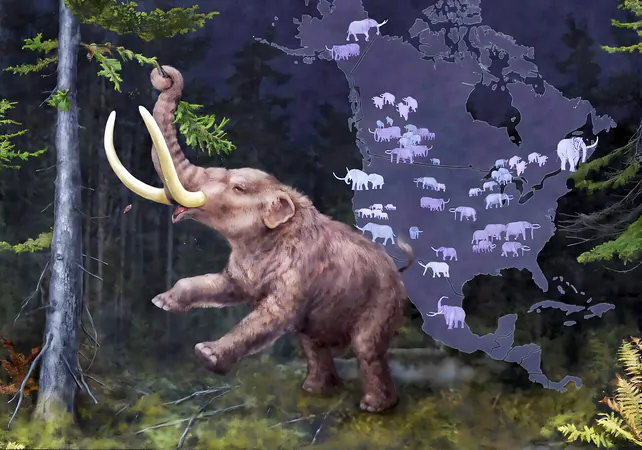
Revealed: The Bold Journeys of Mastodons Unveiling New Species Through DNA Analysis
2025-09-15
Author: Jacob
Mastodons: The Majestic Giants of the Ice Age
Ice Age landscapes were alive with movement as mastodons roamed through ancient forests and swamps, leaving a powerful imprint on North America for millennia. These colossal creatures, resembling modern elephants, have intrigued scientists for generations, yet their evolutionary narrative has remained shrouded in mystery. Were there different species? How far did they travel?
Groundbreaking DNA Study Uncovers Mastodon Diversity
A revolutionary new study has shattered previous assumptions, revealing a fascinating tapestry of mastodon diversity. By meticulously extracting DNA from fossilized remains—tusks, teeth, and bones—that had long been dismissed as too damaged, researchers have constructed detailed genetic histories that showcase how these animals adapted to shifting climates over eons.
The Pacific Mastodon: A Unique Genetic Lineage
Published in the journal *Science Advances*, this study led by scientists from McMaster University and Harvard highlights the distinct genetic branch of the Pacific mastodon, which was previously overshadowed by its American counterpart, Mammut americanum. This new evidence confirms that the Pacific mastodon enjoyed a far-ranging habitat, spanning from the Pacific Northwest potentially down to Mexico and extending northward into Alberta, suggesting an expansive history of adaptation and migration.
Alberta: The Unexpected Hub of Mastodon Activity
Surprisingly, Alberta emerges as a critical crossroads in mastodon history, previously regarded as a marginal area but now recognized as a dynamic migratory corridor. The evidence indicates that both Pacific and American mastodons coexisted here, possibly interbreeding. Senior author Hendrik Poinar remarked on the significance of Alberta as a landscape of interaction and movement, reshaping our understanding of the region during the Ice Age.
Mastodon Migration: A Story of Waves and Cycles
Analysis of specimens from Nova Scotia and northern Ontario revealed striking patterns—DNA indicates that mastodon populations didn’t simply migrate eastward once; they arrived in multiple waves, perfectly aligned with periods of climate warming. This back-and-forth movement showcases a pattern of continual expansion and retreat, reflecting how these giants navigated the ebbs and flows of Ice Age climates.
A New Species May Be Hiding in Mexico
An intriguing discovery emerged from Mexico, where researchers found a specimen with DNA that doesn't align with either Pacific or American mastodon branches. This could symbolize a deeper lineage or even suggest the possibility of a completely new species, emphasizing the profound depth still hidden within mastodon history.
Distinct Lives: Mastodons vs. Mammoths
Often confused with mammoths, mastodons led different lives. While mammoths thrived on grasslands and tundra, mastodons preferred wooded wetlands, focusing their diets on shrubs rather than grasses. This ecological distinction allowed both species to coexist and flourish side by side.
Unanswered Questions and Climate Insights
The study, described as ground-breaking by lead author Emil Karpinski, raises compelling questions about how these diverse mastodon groups interacted in Alberta. Did they compete for resources, or did they crossbreed? To find the answers, more fossil evidence and genetic study are urgently needed. The journey of mastodons serves as a vital reminder of nature's adaptability and resilience.
Legacy and Lessons for Today
The lessons from mastodon adaptations during past climate changes illuminate potential responses to contemporary environmental shifts. Just as these giants responded to warming periods by migrating north and retreating during colder times, modern species are now facing similar challenges. Though mastodons are no longer present, their legacy continues to educate us on the intricate dance of survival and adaptation in a constantly changing world.









 Brasil (PT)
Brasil (PT)
 Canada (EN)
Canada (EN)
 Chile (ES)
Chile (ES)
 Česko (CS)
Česko (CS)
 대한민국 (KO)
대한민국 (KO)
 España (ES)
España (ES)
 France (FR)
France (FR)
 Hong Kong (EN)
Hong Kong (EN)
 Italia (IT)
Italia (IT)
 日本 (JA)
日本 (JA)
 Magyarország (HU)
Magyarország (HU)
 Norge (NO)
Norge (NO)
 Polska (PL)
Polska (PL)
 Schweiz (DE)
Schweiz (DE)
 Singapore (EN)
Singapore (EN)
 Sverige (SV)
Sverige (SV)
 Suomi (FI)
Suomi (FI)
 Türkiye (TR)
Türkiye (TR)
 الإمارات العربية المتحدة (AR)
الإمارات العربية المتحدة (AR)